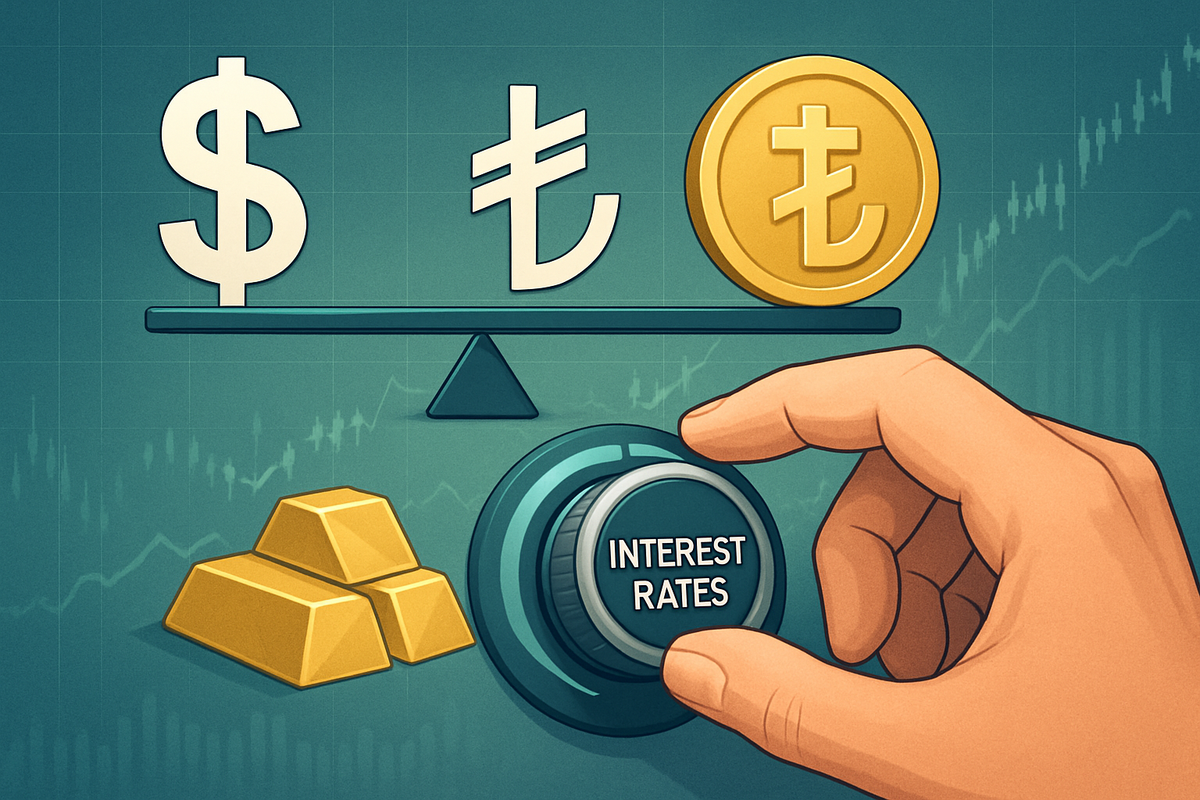
The Central Bank of Turkey (CBT) has ushered in a period of heightened market scrutiny with its latest interest rate decision on October 23, 2025. Delivering a more conservative 100-basis-point cut to its benchmark one-week repo rate, bringing it to 39.5%, the CBT has signaled a notable shift in its aggressive easing cycle. This cautious pivot, following more substantial reductions in prior months, underscores the central bank's delicate balancing act between fostering economic growth and reining in persistent inflationary pressures. The immediate ripple effects are being observed in the US Dollar to Turkish Lira (USD/TRY) exchange rate, which exhibited a minor dip, and have broader implications for market sentiment, particularly reinforcing gold's appeal as a resilient safe-haven asset in an environment of global monetary policy recalibrations.
This strategic adjustment by the CBT is set to influence not only the trajectory of the Turkish Lira but also the investment landscape, as market participants reassess risk and opportunity. The decision highlights a commitment to price stability, even as the central bank navigates complex domestic and international economic headwinds.
Central Bank's Deliberate Pace in Easing Cycle
The Central Bank of Turkey's Monetary Policy Committee (MPC) convened on October 23, 2025, and announced a 100-basis-point reduction in its policy rate, moving it from 40.5% to 39.5%. This decision marked a discernible slowdown in the easing pace that characterized the preceding months. For context, the CBT had implemented a 250-basis-point cut in September and an even larger 300-basis-point reduction in July, indicating a more aggressive stance earlier in the year. While some market analysts had anticipated this 100-basis-point cut, a segment of the market was reportedly expecting a larger cut of around 150 basis points, making the actual decision a signal of increased caution.
The official statement accompanying the rate cut reiterated the CBT's unwavering commitment to achieving and maintaining price stability. The central bank emphasized that future monetary policy decisions would be strictly data-dependent, guided by inflation outcomes, underlying trends, and inflation expectations. Crucially, the CBT also signaled its readiness to employ additional macroprudential measures and tighten policy further should inflation deviate significantly from its interim targets or if monetary transmission mechanisms require support. This forward guidance suggests a flexible and responsive approach, moving away from a predetermined easing path.
Key players in this decision-making process include the Governor of the Central Bank of Turkey, Fatih Karahan, and the members of the Monetary Policy Committee, who are tasked with steering the nation's monetary policy. The Turkish Ministry of Treasury and Finance, led by Minister Mehmet Şimşek, also plays a significant role in shaping the broader economic policy framework within which the CBT operates. Initial market reactions saw the USD/TRY exchange rate at approximately 41.9839 on October 23, 2025, with a minor dip of 0.03% on the day of the announcement to 41.9612. This subtle movement suggests that while the cut was smaller than some expected, the market largely absorbed the news, possibly due to the CBT's clear communication about its commitment to price stability and potential secondary policy tools.
Corporate Fortunes Tied to Lira's Trajectory and Interest Rate Policy
The Central Bank of Turkey's cautious shift in its easing cycle and the resulting implications for the USD/TRY exchange rate will inevitably create winners and losers among public companies operating within and connected to the Turkish economy. Companies with significant foreign currency-denominated debt, particularly those with substantial US dollar liabilities, stand to benefit from a more stable or even appreciating Turkish Lira (TRY). A slower depreciation of the TRY against the USD reduces the cost of servicing their foreign debt, improving their balance sheets and profitability. Conversely, a rapidly depreciating Lira would erode their earnings and increase debt burdens. Turkish Airlines (BIST: THYAO), for instance, with its large operational costs and revenues often denominated in foreign currencies but significant local currency costs, could see its financial performance influenced by the Lira's stability.
On the other hand, Turkish export-oriented companies might find a more stable or appreciating Lira less favorable. A weaker Lira typically makes Turkish exports more competitive on the international market by lowering their price in foreign currency terms. Therefore, a cautious easing cycle that helps stabilize the Lira could marginally reduce the competitive edge for major exporters such as Arçelik (BIST: ARCLK), a leading home appliance manufacturer, or Ford Otosan (BIST: FROTO), a prominent automotive producer. However, the benefit of reduced import costs for raw materials and components could partially offset this. Financial institutions like Akbank (BIST: AKBNK) and Garanti BBVA (BIST: GARAN) will be directly impacted by interest rate changes. A slower pace of rate cuts, or even a potential pause, means a more stable interest rate environment, which can support their net interest margins if lending rates remain relatively high while funding costs are managed. However, if the cautious stance signals prolonged economic uncertainty, it could impact loan demand and asset quality.
The broader market sentiment, especially the renewed appeal of gold as a safe haven, also has implications. Companies involved in gold mining or trading, such as Koza Altın İşletmeleri (BIST: KOZAL), could see increased investor interest and potentially higher revenues if global gold prices continue their bullish trend. Furthermore, companies that rely heavily on imported goods for their domestic sales, such as retailers or technology importers, could benefit from a more stable Lira, as it would reduce their input costs and allow for more predictable pricing for consumers. Conversely, if domestic inflation remains stubbornly high despite the cautious easing, it could continue to suppress consumer purchasing power, impacting domestic-oriented businesses across various sectors.
Wider Implications: A New Chapter for Turkish Economic Policy
The Central Bank of Turkey's decision to pursue a more cautious path in its easing cycle represents a significant moment for Turkish economic policy, signaling a potential new chapter in its fight against inflation and its approach to monetary management. This shift fits into a broader industry trend among emerging markets, where central banks are increasingly balancing growth objectives with the imperative of price stability, often under the watchful eye of international investors. The move away from aggressive rate cuts could be interpreted as a step towards more conventional monetary policy, aiming to anchor inflation expectations and restore credibility. This approach contrasts with previous periods of unconventional monetary policies that led to significant Lira depreciation and high inflation.
The ripple effects of this cautious stance extend beyond Turkey's borders. For regional competitors and trading partners, a more stable Turkish economy and currency could foster greater trade and investment flows. Conversely, continued uncertainty or a renewed surge in inflation, despite the CBT's efforts, could dampen regional economic sentiment. The International Monetary Fund (IMF) and other global financial bodies have consistently advocated for sound monetary policies to combat inflation, and the CBT's current trajectory might be seen as aligning more closely with these recommendations, potentially leading to improved investor confidence and credit ratings in the long run. Historical precedents in Turkey show that periods of aggressive easing without sufficient attention to inflation have often led to significant economic instability and currency crises. The current cautious approach could be a lesson learned from these past experiences, aiming to prevent a repeat of such scenarios.
Regulatory and policy implications are also substantial. A sustained period of cautious monetary policy could necessitate complementary fiscal policies to support disinflationary efforts, potentially involving tighter government spending or revenue-enhancing measures. This integrated approach between monetary and fiscal authorities would be crucial for the success of the CBT's strategy. Furthermore, the CBT's emphasis on using secondary policy tools and macroprudential measures suggests an evolving toolkit to manage liquidity and financial stability, reflecting a more sophisticated and adaptive policy framework. This broader significance highlights Turkey's ongoing efforts to normalize its economic policies and integrate more seamlessly into the global financial system, albeit with the inherent challenges of managing a complex emerging market economy.
The Road Ahead: Navigating Uncertainty and Opportunity
Looking ahead, the Central Bank of Turkey's cautious easing cycle sets the stage for a period of both uncertainty and potential opportunity for the Turkish economy and financial markets. In the short term, market participants will closely scrutinize upcoming inflation data and the CBT's subsequent policy statements for further cues on the pace and direction of monetary policy. The USD/TRY exchange rate is expected to remain sensitive to these developments, with analysts anticipating it to hover within a relatively stable range, possibly between 41.5 and 42.2, assuming no major external shocks or significant policy deviations. The CBT's commitment to using secondary policy tools if inflation re-accelerates suggests a proactive stance, but the effectiveness of these measures will be key to maintaining market confidence.
In the long term, the success of this cautious approach hinges on the CBT's ability to durably bring down inflation expectations and achieve its price stability targets. Should this strategy prove effective, it could pave the way for a more predictable and stable economic environment, encouraging both domestic and foreign investment. Potential strategic pivots for businesses might include recalibrating their hedging strategies against currency fluctuations, optimizing supply chains to mitigate import costs, and adapting pricing strategies to a potentially lower-inflation regime. For foreign investors, a more stable Lira and a credible monetary policy could enhance the attractiveness of Turkish assets, including equities and bonds, as the risk premium associated with the country diminishes.
Market opportunities could emerge in sectors that benefit from increased stability and potentially lower long-term interest rates, such as manufacturing, tourism, and services. Conversely, challenges may arise for companies heavily reliant on a weak Lira for export competitiveness or those operating with high levels of unhedged foreign currency debt. The appeal of gold as a safe haven is likely to persist, particularly given the global trend of central banks accumulating gold reserves and ongoing geopolitical uncertainties. Investors should monitor global interest rate movements, especially from major central banks like the U.S. Federal Reserve, as these will continue to influence global capital flows and the relative attractiveness of various asset classes. The interplay between domestic policy and international economic trends will define the trajectory of the Turkish market in the coming months and years.
Wrap-Up: A Deliberate Path Towards Stability
The Central Bank of Turkey's decision on October 23, 2025, to implement a smaller interest rate cut marks a pivotal moment, signaling a deliberate shift towards a more cautious and data-driven approach in its monetary easing cycle. The key takeaway is the CBT's reinforced commitment to price stability, even if it means a slower pace of monetary accommodation. This measured strategy aims to anchor inflation expectations and restore confidence in the Turkish Lira, which has seen considerable volatility in recent times. The USD/TRY exchange rate's relatively stable reaction to the announcement suggests that markets are cautiously optimistic about this more prudent policy stance, though significant challenges remain.
Moving forward, the market will be closely assessing whether this cautious shift translates into sustained disinflation and greater economic predictability. The CBT's readiness to deploy additional macroprudential tools underscores a proactive and adaptive policy framework, essential for navigating the complex interplay of domestic inflation, global interest rate dynamics, and geopolitical risks. For investors, the enduring appeal of gold as a hedge against uncertainty remains a significant theme, especially as major global central banks also navigate their own monetary policy adjustments.
In the coming months, investors should closely watch the CBT's subsequent policy meetings, inflation reports, and the government's fiscal policy decisions. The convergence of monetary and fiscal policies towards a common goal of stability will be crucial for Turkey's economic health. The success of this deliberate path will not only determine the future trajectory of the Turkish Lira but also the broader investment landscape, potentially opening new avenues for growth while mitigating the risks associated with economic volatility.
This content is intended for informational purposes only and is not financial advice







